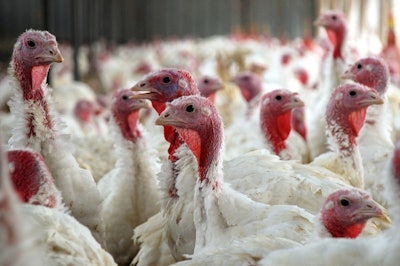
In 2022, North America and Europe experienced some of the worst ever losses due to highly pathogenic avian influenza (HPAI) outbreaks on commercial poultry farms. A different approach to better control the virus is needed for future outbreaks, experts say.
The U.S. Department of Agriculture's (USDA) Animal and Plant Health Inspection Service (APHIS) confirmed the presence of the avian flu in 20 states, including Ohio, Utah, California, Michigan, Wisconsin, Oklahoma, Minnesota, North Dakota, South Dakota, Nebraska, Kansas, Iowa, Missouri, Kentucky, Indiana, Colorado, North Carolina, Pennsylvania, Delaware and Maryland. The virus has also been found in commercial game bird operations in Texas, New York and South Dakota.
Avian influenza causes significant economic and animal welfare challenges for the poultry industry. During the 2015 avian influenza outbreak, U.S. poultry producers lost more than $1.6 billion dollars and 50 million birds died or had to be culled. The total impact of the 2022 avian influenza impact is still unknown, however more than 45 million positive cases of HPAI were reported in commercial poultry.
New biosecurity measures
Traditional approaches to biosecurity failed to stop the spread of highly pathogenic avian influenza in 2022, said Dr. Jean-Pierre Vaillancourt, a professor of veterinary medicine at the Université de Montréal.
Instead, a paradigm shift in biosecurity including new technologies to monitor farm activities is needed to stop future outbreaks of the virus.
“In terms of biosecurity, what we’ve put in place on farms are measures that were already known over 2,000 years ago,” he said.
The two most important rules of biosecurity are to reduce sources of contamination and to create distance between the poultry flock and any potential contamination.
Newly developed temperature monitoring sensors ensure poultry houses, cages, shipping vehicles and all other potential sources of contamination are properly disinfected between flocks.
“With the sensors, you can guarantee that you reached your temperature and duration, so that you’re pretty sure that you got rid of any kind of pathogen,” Vaillancourt said.
Microchips inserted into personal protective equipment (PPE), or onto a hand sanitizer station, offer another new technology to improve biosecurity. The microchips detect if PPE is worn outside the building or if procedures are not followed. People entering and exiting poultry houses are one of the primary vectors of disease spread.
These sort of metrics can help improve compliance with biosecurity protocols by creating real-time feedback for employees and managers. It also aids in identifying areas where additional training is necessary.
Vaccination
Vaccinating against HPAI is another potential option receiving much attention recently.
One potential avian flu vaccine, given at hatch, activates antigens to create a protective immune response in the bird. The unique vaccine design also avoids interference from maternal antibodies. Typically, antibodies help boost the immunity of the chicks at hatch. However, they can also decrease the effectiveness of vaccination.
“The first line is always biosecurity, but if that fails, then our vaccine can develop antibodies which neutralize the virus,” Munir Iqbal, head of The Pirbright Institute’s Avian Influenza Virus group, said.
In addition, the vaccine is easier and less costly to produce than previous avian flu vaccine options, Iqbal said. The Pirbright Institute is a British government-backed research group focused on preventing and controlling viral diseases of livestock and poultry.
The vaccine technology, also known as a targeted antigen delivery vaccine, protected chicks against the H9N2 strain of avian influenza, according to a study published earlier this year in the scientific journal npj Vaccines.
“This target vaccine induced faster and stronger immunity in chicken compared to current inactivated vaccines,” Iqbal said. “It also overcame the interference from the maternal antibodies.”
Mosaic vaccine
One of the biggest challenges in controlling HPAI is how quickly the virus mutates. This means a vaccine targeted toward one strain will quickly become ineffective.
This is why Dr. Adel Talaat, professor of microbiology at the University of Wisconsin-Madison's Laboratory of Infection Genomics, developed a mosaic nanovaccine containing several antibodies to protect against several strains of the virus.
“We use the information that we already have to predict what will be coming next,” he said. “When the new variant comes, we will have the vaccine ready for it.”
To create the mosaic vaccine, researchers collected DNA sequencing data from nearly 20,000 strains of avian influenza. It is designed, to ease its administration to the entire poultry flock, for either oral or aerosol application.
An effective vaccination program for avian influenza could be more cost-effective than depopulation. Stamping out is currently the most used strategy to control the spread of the virus.
“Once you identify avian influenza in a commercial flock, you have to get rid of the entire flock. This is becoming more expensive, especially as it has gotten more frequent,” Talaat said.
“Vaccination is a better strategy. You just have to make sure it’s the right type of vaccine and make sure that it is done appropriate in order to get full protection. I think this will be less expensive in the long run than test and depopulate.”
Although the vaccine is not yet available commercially, Talaat hopes it will help protect against future avian influenza outbreaks.
“Another outbreak is coming,” Talaat said. “This is why we need to have our guards up.”
















